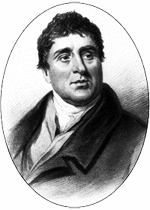
1757 – 1834
Fellow of the Royal Societies of London and Edinburgh
First President of the Institution of Civil Engineers
Engineer for the Holyhead Road 1811-1826
Thomas Telford was born at Glendinning, Eskdale (near Langholm, Dumfries and Galloway) on 9 th August 1757. John Telford, his father, was a shepherd and died in November the same year so the family was very poor. Thomas received elementary education at the local school and also helped out with various jobs around the area. He was known locally as ‘Laughing Tam’. He was treated very kindly by certain local families with whom he maintained contact throughout his life.
At the age of 14 Thomas was apprenticed to a stone mason, and examples of his work can still be seen in Langholm and Westerkirk. In 1780 he moved to Edinburgh and worked in the ‘new’ town around Princes Street. In 1782 he travelled to London and worked on Somerset House under Sir William Chambers and gained promotion to first class mason. He then worked in Portsmouth dockyard as a supervisor from 1784 to 1786 where he developed his design and project management skills.
In 1786 he was employed by William Pulteney to improve Shrewsbury Castle and was appointed Surveyor of Public Works for the County of Shropshire, a post he held until his death. He was responsible for building 3 churches and over 40 bridges in the county, the first being Montford Bridge completed in 1792. Bewdley and Bridgnorth were among his later masonry bridges, and his first iron bridge at Buildwas (1796) advanced the art of building in iron considerably, with many of his similar bridges in various parts of Britain remaining in use today.
Telford was appointed to the Ellesmere Canal Company in 1793 and made his reputation as a civil engineer while responsible for building what is now the Llangollen Canal, including Chirk Aqueduct (1801) and the revolutionary Pontcysyllte Aqueduct (1805).
Following work he had done for the British Fisheries Society, in 1801 he was appointed by the Government to survey and improve communications in the Scottish Highlands. Over the next 20 years or so he was responsible for the construction of nearly 1000 miles (1600 Km) of road, over 1000 bridges, scores of harbours, churches and manses, and the Caledonian Canal running 60 miles (96 KM) from the west to the east coasts.
Telford was also commissioned to design the Gotha ship canal in Sweden which he surveyed in 1808, and planned the whole 114 miles (182 Km) before returning to Britain two months later. The canal was eventually completed in 1832.
In 1811 Telford was appointed to survey the road from Shrewsbury to Holyhead and eventually in 1815 he was commissioned to improve the whole route from London to Holyhead, which included such major works as Waterloo Bridge at Betws y Coed, Nant Ffrancon pass in Snowdonia, Stanley Embankment near Holyhead and, of course, Menai Bridge between Anglesey and mainland Wales. The commission was extended in 1817 to include the Bangor to Chester road which involved the headlands at a Penmaenmawr and Penmaenbach and crossing the Conwy estuary with the embankment and Conwy Suspension bridge. The new route from Llangollen to Bangor was open in 1819 and the whole commission was completed in 1826.
In 1820 Thomas Telford was invited to become the first President of the Institution of Civil Engineers, the oldest professional learned society and qualifying body for the engineering profession in the world. Telford was instrumental in gaining the Institution its Royal Charter in 1828 and served as President until his death on 2 nd September 1834.
